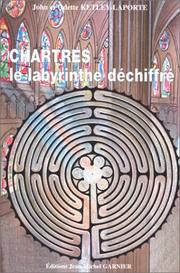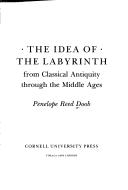| Listing 1 - 10 of 12 | << page >> |
Sort by
|
Book
ISBN: 9781616895129 Year: 2016 Publisher: New York : Princeton Architectural Press,
Abstract | Keywords | Export | Availability | Bookmark
 Loading...
Loading...Choose an application
- Reference Manager
- EndNote
- RefWorks (Direct export to RefWorks)
Labyrinths in art. --- Maze gardens. --- Symbolism in architecture.

ISBN: 2908974045 Year: 1997 Publisher: [lieu de publication inconnu] Éditions Jean-Michel Garnier
Abstract | Keywords | Export | Availability | Bookmark
 Loading...
Loading...Choose an application
- Reference Manager
- EndNote
- RefWorks (Direct export to RefWorks)
Labyrinths in art --- Symbolism in architecture --- Cathédrale de Chartres.
Book
ISBN: 1282362887 9786612362880 3034601506 Year: 2009 Publisher: Gutersloh : Basel ; Boston : Bauverlag ; Birkhauser,
Abstract | Keywords | Export | Availability | Bookmark
 Loading...
Loading...Choose an application
- Reference Manager
- EndNote
- RefWorks (Direct export to RefWorks)
Das Labyrinthische ist eine architektonische Qualität, die nur selten ins Blickfeld von Theorie und Geschichte der Architektur gelangt. Erstaunlich, denn es existiert eine ganze Welt des Verborgenen, Rätselhaften und Schwierigen, die sich dem begrifflichen Zugang entzieht, uns aber ebenso nachhaltig prägt und uns ebenso wichtig ist wie jene, die wir durchschauen. In seiner erstmals 1987 erschienenen, seit langem vergriffenen und nun erneut zugänglichen Arbeit zieht Jan Pieper immer wieder Zeugnisse des Labyrinthischen aus fremden Kulturen heran, in denen die anthropologischen Grundlagen des Labyrinthischen oft schärfere Konturen gewinnen als in den vertrauten Phänomenen der eigenen Kultur. Seine historischen, theoretischen und kulturvergleichenden Untersuchungen nehmen von der chiffrenhaften Labyrinthfigur ihren Ausgang. Im Zentrum aber steht die Vielfalt der Labyrinthideen, die in architektonischen Andeutungen, Gesten und Assoziationen des bedeutsamen Bauens stets mitschwingen. Jan Piepers im Wortsinne wundervolles Werk erschließt so die Ideen und die Ausdrucksformen der bewußten Verrätselung als subtilster Form architektonischer Ordnung.
Labyrinths in art. --- Architecture --- Symbolism in architecture. --- Aesthetics.
Book
ISBN: 2844262759 9782844262752 Year: 2005 Publisher: Paris: Centre Pompidou,
Abstract | Keywords | Export | Availability | Bookmark
 Loading...
Loading...Choose an application
- Reference Manager
- EndNote
- RefWorks (Direct export to RefWorks)
Ce livre est un dédale. Vous allez y errer et vous y fourvoyer, avant de pénétrer un peu mieux le labyrinthe de Jeppe Hein. Car il s'agira de livrer le secret du "labyrinthe invisible".
Installation-art --- Labyrinthe --- Labyrinths in art --- Hein, Jeppe --- Hein, Jeppe, - 1974-
Book
ISBN: 2879007763 9782879007762 Year: 2003 Publisher: Paris: Paris Musées,
Abstract | Keywords | Export | Availability | Bookmark
 Loading...
Loading...Choose an application
- Reference Manager
- EndNote
- RefWorks (Direct export to RefWorks)
Symbole universel et intemporel, la figure labyrinthique continue de nous fasciner et nous renvoie à nos interrogations les plus profondes. La richesse des œuvres et la diversité des artistes illustrent la pérennité du mythe à travers les siècles. Les auteurs qui ont participé à cet ouvrage y apportent l'éclairage de leur propre sensibilité. Autant de regards croisés pour aider le lecteur à cheminer une fois les portes du labyrinthe franchies.
Labyrinths in art --- Art and mythology --- Labyrinthes dans l'art --- Art et mythologie --- Exhibitions. --- Expositions --- Expositions

ISBN: 0801423937 1501738461 0801480000 1501738453 Year: 1990 Publisher: Ithaca (N.Y.): Cornell university press
Abstract | Keywords | Export | Availability | Bookmark
 Loading...
Loading...Choose an application
- Reference Manager
- EndNote
- RefWorks (Direct export to RefWorks)
Ancient and medieval labyrinths embody paradox, according to Penelope Reed Doob. Their structure allows a double perspective-the baffling, fragmented prospect confronting the maze-treader within, and the comprehensive vision available to those without. Mazes simultaneously assert order and chaos, artistry and confusion, articulated clarity and bewildering complexity, perfected pattern and hesitant process. In this handsomely illustrated book, Doob reconstructs from a variety of literary and visual sources the idea of the labyrinth from the classical period through the Middle Ages.Doob first examines several complementary traditions of the maze topos, showing how ancient historical and geographical writings generate metaphors in which the labyrinth signifies admirable complexity, while poetic texts tend to suggest that the labyrinth is a sign of moral duplicity. She then describes two common models of the labyrinth and explores their formal implications: the unicursal model, with no false turnings, found almost universally in the visual arts; and the multicursal model, with blind alleys and dead ends, characteristic of literary texts. This paradigmatic clash between the labyrinths of art and of literature becomes a key to the metaphorical potential of the maze, as Doob's examination of a vast array of materials from the classical period through the Middle Ages suggests. She concludes with linked readings of four "labyrinths of words": Virgil's Aeneid, Boethius' Consolation of Philosophy, Dante's Divine Comedy, and Chaucer's House of Fame, each of which plays with and transforms received ideas of the labyrinth as well as reflecting and responding to aspects of the texts that influenced it.Doob not only provides fresh theoretical and historical perspectives on the labyrinth tradition, but also portrays a complex medieval aesthetic that helps us to approach structurally elaborate early works. Readers in such fields as Classical literature, Medieval Studies, Renaissance Studies, comparative literature, literary theory, art history, and intellectual history will welcome this wide-ranging and illuminating book.
Doolhoven in de literatuur --- Labyrinten in de literatuur --- Labyrinthes dans la littérature --- Labyrinths in literature --- Classical literature --- -Labyrinths in art --- Literature, Medieval --- -European literature --- Medieval literature --- Literature, Classical --- Literature --- Literature, Ancient --- Greek literature --- Latin literature --- History and criticism --- Labyrinths in art. --- Labyrinths in literature. --- History and criticism. --- -History and criticism --- Labyrinths in art --- Literature [Medieval ]
Book
ISBN: 0801480000 1501738453 1501738461 Year: 1992 Publisher: Ithaca, N.Y. Cornell University Press
Abstract | Keywords | Export | Availability | Bookmark
 Loading...
Loading...Choose an application
- Reference Manager
- EndNote
- RefWorks (Direct export to RefWorks)
Ancient and medieval labyrinths embody paradox, according to Penelope Reed Doob. Their structure allows a double perspective-the baffling, fragmented prospect confronting the maze-treader within, and the comprehensive vision available to those without. Mazes simultaneously assert order and chaos, artistry and confusion, articulated clarity and bewildering complexity, perfected pattern and hesitant process. In this handsomely illustrated book, Doob reconstructs from a variety of literary and visual sources the idea of the labyrinth from the classical period through the Middle Ages.Doob first examines several complementary traditions of the maze topos, showing how ancient historical and geographical writings generate metaphors in which the labyrinth signifies admirable complexity, while poetic texts tend to suggest that the labyrinth is a sign of moral duplicity. She then describes two common models of the labyrinth and explores their formal implications: the unicursal model, with no false turnings, found almost universally in the visual arts; and the multicursal model, with blind alleys and dead ends, characteristic of literary texts. This paradigmatic clash between the labyrinths of art and of literature becomes a key to the metaphorical potential of the maze, as Doob's examination of a vast array of materials from the classical period through the Middle Ages suggests. She concludes with linked readings of four "labyrinths of words": Virgil's Aeneid, Boethius' Consolation of Philosophy, Dante's Divine Comedy, and Chaucer's House of Fame, each of which plays with and transforms received ideas of the labyrinth as well as reflecting and responding to aspects of the texts that influenced it.Doob not only provides fresh theoretical and historical perspectives on the labyrinth tradition, but also portrays a complex medieval aesthetic that helps us to approach structurally elaborate early works. Readers in such fields as Classical literature, Medieval Studies, Renaissance Studies, comparative literature, literary theory, art history, and intellectual history will welcome this wide-ranging and illuminating book.
Comparative literature --- anno 500-1499 --- Antiquity --- Classical literature --- Labyrinths in art --- Labyrinths in literature --- Literature, Medieval --- Littérature ancienne --- Labyrinthes dans l'art --- Labyrinthes dans la littérature --- Littérature médiévale --- History and criticism --- Histoire et critique --- Littérature ancienne --- Labyrinthes dans la littérature --- Littérature médiévale --- Labyrinths in art. --- Labyrinths in literature. --- History and criticism.
Book
ISBN: 3528087080 9783528087081 Year: 1987 Publisher: Braunschweig Vieweg
Abstract | Keywords | Export | Availability | Bookmark
 Loading...
Loading...Choose an application
- Reference Manager
- EndNote
- RefWorks (Direct export to RefWorks)
Symbolism in architecture --- Labyrinths in art --- Labyrinths --- Labyrinten --- Doolhoven --- 72.03 --- 72.012/013 --- 7.013 --- Jan Pieper --- architectuur --- stedenbouw --- architectuurtheorie --- architectuurgeschiedenis --- ontwerp --- vorm --- patronen --- labyrinten --- doolhoven --- alchemie --- 72.011 --- 711.1 --- Mazes --- Architectural symbolism --- Signs and symbols in architecture --- Architecture --- Architectuur (geschiedenis) --- Architectuurgeschiedenis --- Vorm (architectuur) --- Vorm (kunst) --- Labyrinths in art. --- Labyrinths. --- Symbolism in architecture.
Book
ISBN: 3892449333 9783892449331 3892449333 Year: 2007 Publisher: Göttingen : Wallstein,
Abstract | Keywords | Export | Availability | Bookmark
 Loading...
Loading...Choose an application
- Reference Manager
- EndNote
- RefWorks (Direct export to RefWorks)
Labyrinths in art --- Labyrinths --- Play --- Play in literature --- Play in art --- Labyrinths in literature --- Labyrinthes dans l'art --- Labyrinthes --- Labyrinthes dans la littérature --- Jeu --- Jeu dans la littérature --- Jeu dans l'art --- Labyrinthes dans la littérature --- Jeu dans la littérature
Book
ISBN: 3926530766 9783926530769 Year: 1996 Publisher: Krefeld Stadt Krefeld
Abstract | Keywords | Export | Availability | Bookmark
 Loading...
Loading...Choose an application
- Reference Manager
- EndNote
- RefWorks (Direct export to RefWorks)
Drawing --- parks [recreation areas] --- Photography --- photography [process] --- labyrinths [motifs] --- Iconography --- gardens [open spaces] --- Vercruysse, Jan --- anno 1900-1999 --- Belgium --- Labyrinths in art --- Labyrinthes dans l'art --- Text Pier Luigi Tazzi --- doolhoven --- labyrinten --- prints [visual works] --- kunst --- twintigste eeuw --- installaties --- België --- tuinarchitectuur --- Vercruysse Jan --- fotografie --- 7.071 VERCRUYSSE --- Photography, Artistic --- Installations (Art) --- Photographie artistique --- Exhibitions. --- Exhibitions --- Expositions
| Listing 1 - 10 of 12 | << page >> |
Sort by
|

 Search
Search Feedback
Feedback About UniCat
About UniCat  Help
Help News
News